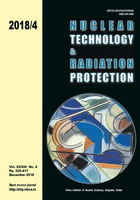
RADIONUCLIDE AND HEAVY METAL CONTENT IN THE TABLE OLIVE (OLEA EUROPAEA L.) FROM THE MEDITERRANEAN REGION OF TURKEY

Vol.
XXXIII, No. 4, Pp. 325-417
December 2018
UDC 621.039+614.876:504.06
ISSN 1451-3994
Pages: 386-394
Authors: Muhammet KaratasliAbstract
This study presents the concentrations of radionuclides and heavy metals in twenty-six table olive (Olea europaea L.) samples, and an assessment of the health risks associated with their consumption. The samples were collected from different towns in the Mediterranean region of Turkey, one of the major olive-producing countries in the world. The average activity concentrations of 226Ra, 232Th, 40K, and 137Cs in the edible parts of the table olive samples were found as 37.9 ± 4.1, 7.1 ± 0.5, 274.6 ± 14.7, and 7.2 ± 0.7 Bqkg (dw), respectively, by using a gamma ray spectrometer. The effective radiation dose due to the intake of these radionuclides through ingestion of olive samples varied from 3.4 to 22.7 µSv with an average value of 11 ± 1 µSv. The average concentrations of Cr, Mn, Fe, Co, Ni, Cu, Zn, Sr, and Pb in the edible parts of the table olive samples were determined as 2.04, 11.08, 166.60, 0.20, 10.29, 13.81, 14.34, 4.50, and 4.55 µgg-1, respectively, by using an inductively coupled plasma optical emission spectrometer. Based on the measured content of the radionuclides and heavy metals, the results imply that table olives are safe for human consumption.
Key words: table olive, radionuclide, heavy metal, annual effective dose, gamma ray spectrometry, optical emission spectrometry
FULL PAPER IN PDF FORMAT (18.84 MB)